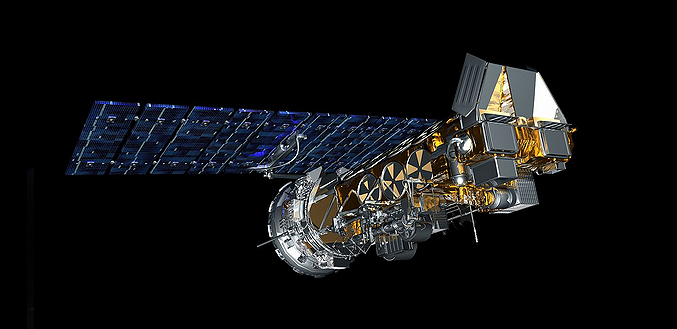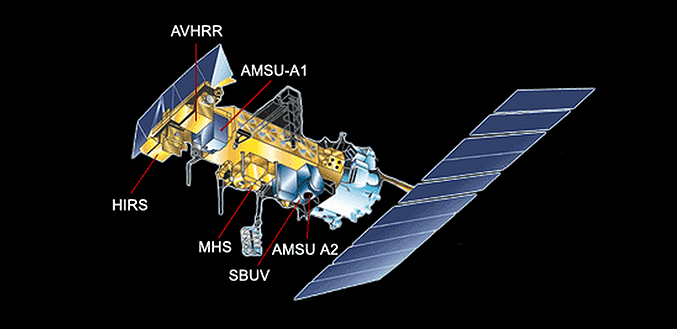
- INFORMATION
NOAA

NOAA-N is the latest polar-orbiting satellite developed by NASA for the National Oceanic and Atmospheric Administration (NOAA). NOAA-N will collect information about Earth's atmosphere and environment to improve weather prediction and climate research across the globe.
NOAA-N is the 15th in a series of polar-orbiting satellites dating back to 1978. NOAA uses two satellites, a morning and afternoon satellite, to ensure every part of the Earth is observed at least twice every 12 hours.
Severe weather is monitored and reported to the National Weather Service which broadcasts the findings to the global community. With the early warning, effects of catastrophic weather events can be minimized.
NOAA-N also has instruments to support an international search-and-rescue program. The Search and Rescue Satellite-Aided Tracking System, called COPAS-SARSAT, transmits to ground stations the location of emergency beacons from ships, aircraft and people in distress around the world. The program, in place since 1982, has saved about 18,000 lives.
NOAA-N is the first in a series of polar-orbiting satellites to be part of a joint cooperation project with the European Organisation for the Exploitation of Meteorological Satellites (EUMESTAT).
The spacecraft carries the following instruments: an Advanced Very High Resolution Radiometer (AVHRR/3), a High Resolution Infrared Radiation Sounder (HIRS/3), an Advanced Microwave Sounding Unit-A (AMSU-A), a Microwave Humidity Sounder (MHS), a Solar Backscatter Ultraviolet Radiometer (SBUV/2), a Space Environment Monitor (SEM-2), a Data Collection System (DCS/2), a Search and Rescue Repeater and Sounder (SARR and SARP), and a Digital Data Recorder (DDR).
NOAA-N is the 15th in a series of polar-orbiting satellites dating back to 1978. NOAA uses two satellites, a morning and afternoon satellite, to ensure every part of the Earth is observed at least twice every 12 hours.
Severe weather is monitored and reported to the National Weather Service which broadcasts the findings to the global community. With the early warning, effects of catastrophic weather events can be minimized.
NOAA-N also has instruments to support an international search-and-rescue program. The Search and Rescue Satellite-Aided Tracking System, called COPAS-SARSAT, transmits to ground stations the location of emergency beacons from ships, aircraft and people in distress around the world. The program, in place since 1982, has saved about 18,000 lives.
NOAA-N is the first in a series of polar-orbiting satellites to be part of a joint cooperation project with the European Organisation for the Exploitation of Meteorological Satellites (EUMESTAT).
The spacecraft carries the following instruments: an Advanced Very High Resolution Radiometer (AVHRR/3), a High Resolution Infrared Radiation Sounder (HIRS/3), an Advanced Microwave Sounding Unit-A (AMSU-A), a Microwave Humidity Sounder (MHS), a Solar Backscatter Ultraviolet Radiometer (SBUV/2), a Space Environment Monitor (SEM-2), a Data Collection System (DCS/2), a Search and Rescue Repeater and Sounder (SARR and SARP), and a Digital Data Recorder (DDR).

- AVHRR/3
The AVHRR/3 is a six channel imaging radiometer that detects energy in the visible IR portions of the electromagnetic spectrum. It measures reflected solar (visible and near-IR) energy and radiated thermal energy from land, sea, clouds, and the intervening atmosphere.
- HIRS/4
The HIRS/4 is an atmospheric sounding instrument that provides multispectral data from one visible channel, seven shortwave channels, and twelve longwave channels using a single telescope and a rotating filter wheel containing twenty individual spectral filters.
- AMSU-A
The AMSU-A is a cross-track scanning total power radiometer, which is divided into two physically separate modules that interface with the spacecraft independently. The AMSU-A measures scene radiance in the microwave spectrum. The data from this instrument is used in conjunction with the HIRS and provides precipitation and surface measurements including snow cover, sea ice concentration, and soil moisture.
- MHS
The MHS is a new instrument for the NOAA series of satellites. It is a five-channel microwave instrument intended primarily to measure profiles of atmospheric humidity. Additionally, it measures cloud liquid water content and provides qualitative estimates of the precipitation rate.
- SBUV/2
The SBUV/2 is a nadir-pointing, nonspatial, spectrally scanning, ultraviolet radiometer carried in two modules - the Sensor Module and the Electronics Module. This instrument measures solar irradiance and Earth radiance (backscattered solar energy) in the near ultraviolet spectrum.
Referred by NASA(http://www.nasa.gov/mission_pages/noaa-n/main/index.html) website
Referred by NASA(http://www.nasa.gov/mission_pages/noaa-n/main/index.html) website


